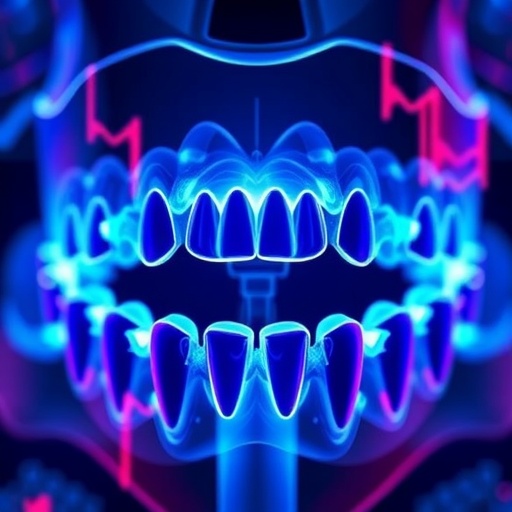In a groundbreaking development poised to transform dental care, researchers at the University of Texas at Dallas have pioneered a highly innovative method for manufacturing zirconia dental restorations using 3D printing technology. This breakthrough enables the production of permanent, all-ceramic dental crowns, bridges, and veneers within a single day — a feat previously unattainable due to longstanding processing bottlenecks surrounding zirconia materials. By substantially accelerating the thermal debinding process, the team’s novel technique promises to revolutionize chair-side restorative dentistry, enhancing customization, efficiency, and patient convenience.
Zirconia is widely acknowledged within dentistry as the gold standard for permanent restorations due to its exceptional strength, durability, and biocompatibility. Despite its widespread clinical use, currently available techniques for producing zirconia crowns fall short in terms of speed and design flexibility. While 3D printing has emerged in dentistry as a means of creating resin-based crowns with rapid turnaround times, these materials do not match zirconia’s mechanical robustness. Conversely, same-day zirconia restorations do exist but rely on subtractive milling technologies that carve restorations from solid blocks. This approach inherently constrains the geometric complexity achievable and carries a risk of micro-cracks forming during the milling and sintering stages.
Overcoming these limitations, the University of Texas at Dallas team has successfully engineered a solution to fabricate zirconia restorations via vat photopolymerization-based 3D printing followed by a radically streamlined thermal treatment protocol. The critical challenge addressed is the debinding phase — a high-temperature process used to remove the polymeric binder that temporarily holds zirconia particles together post printing. Traditional debinding extends over 20 to 100 hours due to the slow off-gassing needed to prevent crown fractures caused by rapid gas formation.
The research, as detailed in the journal Ceramics International, introduces a single-step thermal debinding protocol condensing hours-long processing into less than 30 minutes. This is achieved through an enhanced heat transfer mechanism utilizing highly porous graphite felt. The felt not only sustains elevated temperatures surpassing 2,550°F but also facilitates the controlled escape of decomposition gases from the resin matrix. Accompanying the felt is a vacuum system that actively evacuates evolved gases, avoiding the buildup of internal pressure that compromises the crown’s structural integrity.
This synergistic approach to thermal debinding fundamentally alters the kinetics of polymer burnout kinetics by sharply reducing thermal gradients and enabling uniform temperature distribution through the crown. The resultant ceramic body densifies without the common defect modes seen in conventional slow debinding or milling techniques. Following rapid debinding, the crown undergoes sintering, a high-temperature firing step that fuses the zirconia particles into a dense, homogenous solid with excellent mechanical properties, ultimately producing a restoration of clinical quality suitable for permanent use.
From a clinical workflow perspective, the implications are profound. Dentists equipped with this technology can scan a patient’s dentition, digitally design a customized crown, and fabricate a zirconia restoration within hours during a single appointment. This reduces treatment times dramatically and eliminates temporary prostheses, which patients often find inconvenient. Moreover, the additive manufacturing method of photopolymerization affords superior design freedom compared to milling, enabling intricate geometries and precise color-matching enhancements tailored to individual patients.
The pioneering technology, currently undergoing clinical validation and regulatory review, is poised for commercialization thanks to a $550,000 grant from the National Science Foundation’s Partnerships for Innovation program. Collaboration with industry partners such as Pan-AM Dental Laboratory and 3DCeram Sinto Inc., as well as input from dental professionals including Dr. Amirali Zandinejad, a prosthodontist and academic, help accelerate the translation of this research into practical chair-side applications and commercial products.
Detailed contributions to this research team include doctoral candidates specializing in mechanical engineering and chemistry, highlighting the interdisciplinary nature essential to marrying advanced materials science with biomedical engineering challenges. The investigation has also benefited from support by the U.S. Air Force Office of Scientific Research, evidencing the broad interest and potential applications of this thermal processing technology beyond dentistry.
Beyond the immediate dental applications, this method’s capacity for rapid, high-temperature debinding could influence broader domains of ceramics manufacturing where speed and microstructural integrity are critical. The scalability and adaptability of the approach may herald new advancements in medical device fabrication, aerospace components, and industrial ceramics, underscoring the transformative potential of this advance in additive manufacturing.
In summary, the University of Texas at Dallas’s development of a rapid thermal debinding protocol within 3D printing zirconia dental restorations addresses a crucial unmet need in precision dentistry. Combining enhanced heat transfer materials, vacuum-assisted off-gassing, and vat photopolymerization printing, the technology enables same-day fabrication of durable, biocompatible ceramic crowns. This innovation promises not only to improve clinical outcomes and patient experiences but also to establish new paradigms in the manufacturing of complex ceramic components.
Subject of Research:
Not applicable
Article Title:
Single-step thermal debinding for ceramics vat photopolymerization in less than 30 minutes
News Publication Date:
1-Aug-2025
Web References:
https://www.sciencedirect.com/science/article/abs/pii/S0272884225023417
References:
DOI: 10.1016/j.ceramint.2025.05.206
Image Credits:
The University of Texas at Dallas
Keywords:
Medical equipment, Engineering, Mechanical engineering, Health and medicine, Technology, Dentistry, Fabrication




